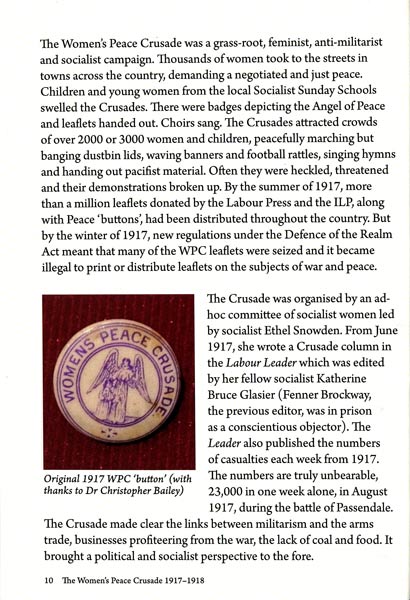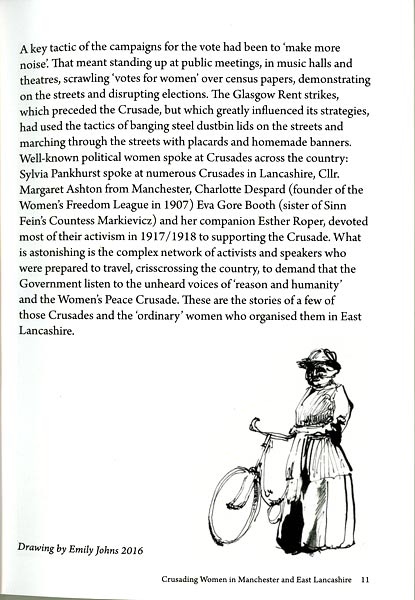
Page 10
|
The Women's Peace Crusade was a grass-root, feminist, anti-militarist and socialist campaign. Thousands of women took to the streets in towns across the country, demanding a negotiated and just peace. Children and young women from the local Socialist Sunday Schools swelled the Crusades. There were badges depicting the Angel of Peace and leaflets handed out. Choirs sang. The Crusades attracted crowds of over 2000 or 3000 women and children, peacefully marching but banging dustbin lids, waving banners and football rattles, singing hymns and handing out pacifist material. Often they were heckled, threatened and their demonstrations broken up. By the summer of 1917, more than a million leaflets donated by the Labour Press and the ILP, along with Peace 'buttons', had been distributed throughout the country. But by the winter of 1917, new regulations under the Defence of the Realm Act meant that many of the WPC leaflets were seized and it became illegal to print or distribute leaflets on the subjects of war and peace.
The Crusade was organised by an ad-hoc committee of socialist women led by socialist Ethel Snowden. From June 1917, she wrote a Crusade column in the Labour Leader which was edited by her fellow socialist Katherine Bruce Glasier (Fenner Brockway, the previous editor, was in prison as a conscientious objector). The Leader also published the number of casualties each week from 1917. The numbers are truly unbearable, 23,000 in one week alone, in August 1917, during the battle of Passchendaele. The Crusade made clear the links between militarism and the arms trade, businesses profiteering from the war, the lack of coal and food. It brought a political and socialist perspective to the fore.
Page 10
|

Page 11
|
A key tactic of the campaigns for the vote had been to 'make more noise'. That meant standing up at public meetings, in music halls and theatres, scrawling 'votes for women' over census papers, demonstrating on the streets and disrupting elections. The Glasgow rent strikes, which preceded the Crusade, but which greatly influenced its strategies, had used the tactics of banging steel dustbin lids on the streets and marching through the streets with placards and homemade banners. Well-known political women spoke at Crusades across the country: Sylvia Pankhurst spoke at numerous Crusades in Lancashire, Cllr. Margaret Ashton from Manchester, Charlotte Despard (founder of the Women's Freedom League in 1907), Eva Gore Booth (sister of Sinn Fein's Countess Markiewicz) and her companion Esther Roper, devoted most of their activism in 1917/1918 to supporting the Crusade. What is astonishing is the complex network of activists and speakers who were prepared to travel, criss-crossing the country, to demand that the Government listen to the unheard voices of 'reason and humanity' and the Women's Peace Crusade. These are the stories of a few of those Crusades and the 'ordinary' women who organised them in East Lancashire.
Page 11
|


